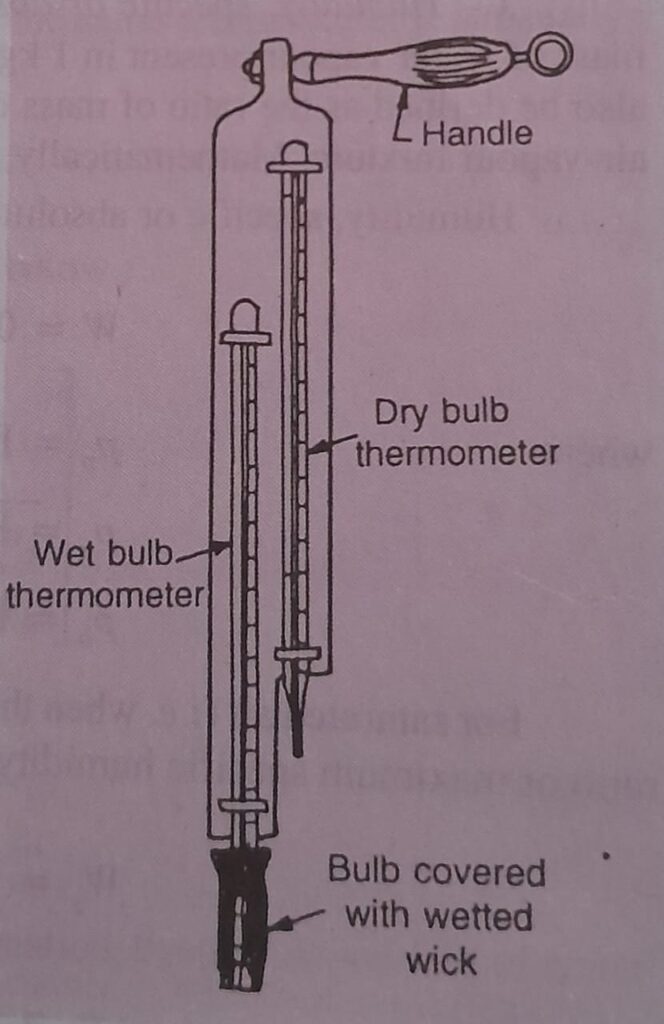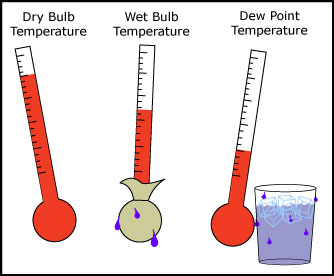The psychrometry is that branch of engineering science which deals with the study of moist air i.e. dry air mixed with water vapour or humidity.
Studying Psychrometry helps to understand the different parts of the air and how they interact, which also reveals various mysteries of atmosphere and nature. Some of the air conditioning features we will study are: dry bulb temperature, wet temperature, dew temperature, relative humidity etc.
Different terms used in psychometry
Table of Contents
1. Dry air :
The pure dry air is a mixture of number of gases such as nitrogen, oxygen, carba dioxide, hydrogen, argon, neon, helium etc. but the nitrogen and oxygen have the major portion of the combination.
2. Moist air :
It is a mixture of dry air and water vapour. The amount of water vapour, present in the air, depends upon the absolute pressure and temperature of the mixture.
3. Saturated air :
It is a mixture of dry air and water vapour, when the air has diffused the maximum amount of water vapour into it.
4. Degree of saturation :
It is the ratio of actual mass of water vapour in a unit mass of dry air to the mass of water vapour in the same mass of dry air when it is saturated at the same temperature and pressure.
5. Humidity :
It is the mass of water vapour present in 1 kg of dry air, and is generally expressed in terms of gram per kg of dry air (g/kg of dry air). It is also called “specific humidity’ or ‘humidity ratio.”
6. Absolute humidity :
It is the mass of water vapour present in 1 m³ of dry air, and is generally expressed in terms of gram per cubic metre of dry air (g/m³ of dry air).
7. Relative humidity :
It is the ratio of actual mass of water vapour in a given volume of moist air to the mass of water vapour in the same volume of saturated air at the same temperature and pressure.
8. Dry bulb temperature :
It is the temperature of air recorded by a thermometer, when it is not affected by the moisture present in the air.
Dry-Bulb Temperature, usually referred to as the air temperature, is the air property that is most commonly used. People referring to air temperature normally referring to Dry Bulb Temperature.
9. Wet bulb temperature :
It is the temperature of air recorded by a thermometer, when its bulb is surrounded by a wet cloth exposed to the air. Such a thermometer is called ‘wet bulb thermometer.’
Wet-Bulb Temperatures are always lower than dry bulb temperatures with less than 100% relative humidity in the air.
10. Wet bulb depression :
It is the difference between dry bulb temperature and wet bulb
temperature at any point. The wet bulb depression indicates relative humidity of the air.
11. Dew point temperature :
It is the temperature of air recorded by a thermometer, when the moisture (water vapour) present in it begins to condense.
In other words, the dew point temperature
is the saturation temperature corresponding to the partial pressure of water vapour.
Note: For saturated air, the dry bulb temperature, wet bulb temperature and dew point temperature is same.

12. Dew point depression :
It is the difference between the dry bulb temperature and dew point temperature of air.
That was all about the psychrometry and its terminologies. I hope this will help you a lot. If you fresh like this content then do share this with your mates and friends. Also do check out and subscribe our website for each and every mechanical engineering topics and knowledge
FAQ’s
Q1. A mixture of dry air and water vapour, when the air has diffused the maximum amount of water vapour into it, is called
Saturated air
Q2. What is degree of saturation ?
It is the ratio of the actual mass of water vapour in a unit mass of dry air to the mass of water vapour in the same mass of dry air when it is saturated at the same temperature and pressure.
3. What is relative humidity ?
It is the ratio of actual mass of water vapour in a given volume of moist air to the mass of water vapour in the same volume of saturated air at the same temperature and pressure.
Q4. The mass of water vapour present in _ is called absolute humidity.
1 m^3 of dry air.
Q5. For unsaturated air, the dew point temperature is…….. wet bulb temperature.
Less than
Q6. The difference between dry bulb temperature and wet bulb temperature, is called ?
Wet bulb depression
Q7. The difference between dry bulb temperature and dew point temperature, is called ?
Dew point depression
Q8. The wet bulb depression is zero when relative humidity is ?
1
Q9. The wet bulb depression indicates ___humidity of the air.
Relative
10. According to Dalton’s law of partial pressures
Pb = Pa + Pv
